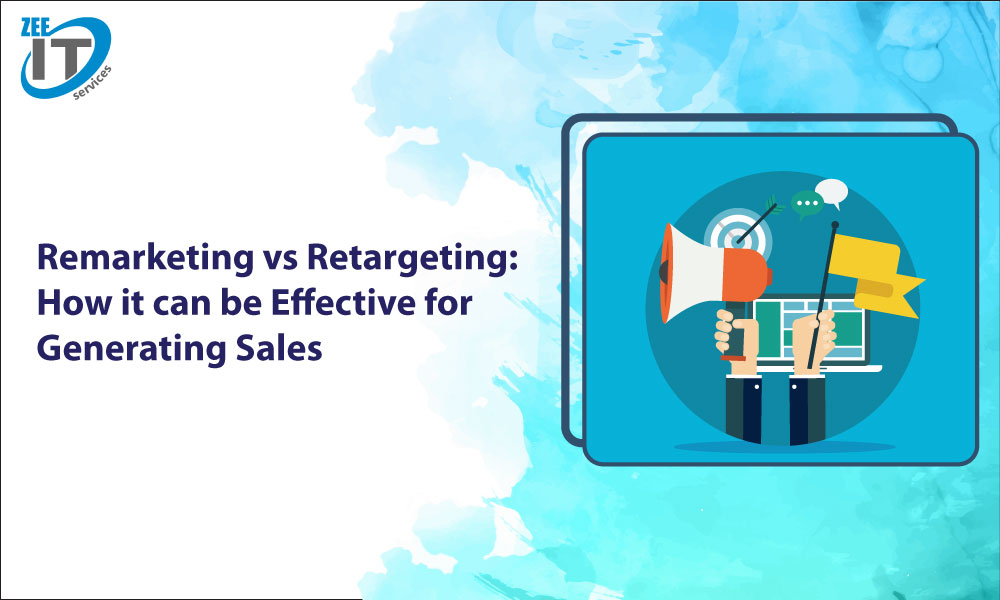Two crucial marketing pillars are retargeting and remarketing. When you see different ads for products on a website or receive emails about a particular product, this happens due to remarketing and retargeting. But most people do not differentiate between both of these terms and consider both terms to be the same which is wrong. Let me clarify to you that the Retargeting and Remarketing terms are technically different, the strategy of both terms is different but the purpose of both terms is the same.
Both techniques are used to attract potential clients back to your website and increase the chances that they will convert to sales because 96% of visitors are likely to leave your site without converting, so it is crucial to use these strategies for conversions when you see different product ads on websites or receive emails about a specific product.
But if you don’t know the main difference between both strategies, you may be lacking down into your strategies and efforts. So first let’s understand the main difference between both terms individually and then compare them so you better understand your main goal and design your strategy accordingly.
What is Remarketing?
Remarketing is focusing on visitors who have interacted in some way with your website or brand in the past. Usually, it uses email lists or cookies to get in touch with these people again on different websites. Furthermore, remarketing’s main objective is to re-engage prospective clients who have expressed interest but haven’t finished a desired action—like completing a form or making a purchase.
Let’s use an example to better understand it: You go to an online shoe retailer and explore their selection of footwear. While you’re interested, you decide not to purchase at that moment. Later, you receive an email from the shoe store with a personalized message, offering you a discount on the sneakers you viewed. This is a remarketing strategy since the retailer is contacting you through email based on your past experience with their website.
What is Retargeting?
Retargeting, on the other hand, aims to show advertisements to those who have already visited your website but haven’t made a purchase. Unlike remarketing, which targets users based on previous interactions, retargeting specifically aims to recapture the attention of visitors who have demonstrated some level of interest by navigating through your site. Businesses can notify these people about their goods or services and encourage them to come back and finish a desired action by placing retargeting advertisements strategically.
Like after browsing for sneakers on the shoe store’s website, you continue to surf the internet and visit a news website. As you scroll through the articles, you notice display ads featuring the same sneakers you were considering earlier. The shoe retailer uses retargeting to carefully display these adverts on the news website. By adding a retargeting pixel to their website, they can track your visits and show you similar advertising when you browse other websites in an attempt to grab your interest again.
Remarketing vs. Retargeting: The similarities
Now you may wonder why people consider these terms the same so let me clarify their similarities and on which basis others consider them the same. Both remarketing and retargeting are highly effective strategies for driving sales and conversions which shows their objectives and goals are the same. Both remarketing and retargeting involve marketing to users who have already interacted with your brand. Often, these users haven’t yet made a purchase. Whether they’ve browsed your website, added items to their cart, or interacted with your brand in some other way, these individuals represent valuable opportunities for conversion. By targeting them with personalized ads or messages, businesses can nurture leads, encourage repeat purchases, and maximize the lifetime value of their customers.
How does Remarketing differ from Retargeting?
As we have discussed now remarketing and retargeting share similar objectives, but their methodologies and targeting criteria vary. Remarketing primarily targets users who have interacted with your brand across multiple channels, including websites, social media platforms, and email. In contrast, retargeting focuses specifically on individuals who have visited your website but haven’t converted, tailoring ads based on their browsing behavior and interests. Let’s see their primary difference in detail:
Remarketing vs. retargeting: The differences
The primary difference between remarketing and retargeting lies in their targeting criteria and audience segmentation. Remarketing targets users based on their previous interactions with your brand across various channels, while retargeting focuses specifically on individuals who have visited your website but haven’t converted. Additionally, remarketing tends to have a broader reach, targeting users across multiple platforms, while retargeting is more narrowly focused on recapturing the attention of website visitors.
How to use Remarketing?
To use Remarketing strategies take several steps that include:
- Segmentation: To present more relevant advertisements, divide your audience into smaller groups according to their demographics, interests, or behavior.
- Personalization: To increase the chance of conversion, modify your offerings and messaging to appeal to each target category.
- Optimization: Continuously monitor and optimize your campaigns by testing different ad creatives, placements, and targeting criteria to improve performance.
Types of Remarketing
- Standard Remarketing: Show ads to past visitors as they browse websites and apps.
- Dynamic Remarketing: Display personalized ads to users based on their past interactions with your website or products.
- Email Remarketing: Send targeted emails to users who have abandoned their carts or visited specific pages on your website.
How to use Retargeting?
The retargeting process also differs from the remarketing process so let’s see:
- Pixel Installation: Install retargeting pixels on your website to track visitors and display ads to them as they browse other websites.
- Audience Segmentation: Segment your retargeting audience based on their behavior and interests to deliver more relevant ads.
- Ad Creatives: Create compelling ad creatives that grab the attention of your retargeting audience and encourage them to revisit your website.
Retargeting Ad Types
- Display Ads: Banner ads displayed on other websites that target individuals who have previously visited your site.
- Social Media Ads: Sponsored posts or ads on social media platforms targeting users who have interacted with your brand.
- Search Ads: Text ads displayed on search engine results in pages targeting users who have previously visited your website.
Which is Better, Remarketing or Retargeting?
Both remarketing and retargeting have their unique strengths and can be effective in driving sales and conversions. The choice between the two depends on your specific goals, target audience, and the nature of your business. Remarketing is ideal for maintaining brand awareness and nurturing leads across multiple channels while retargeting focuses on recapturing the attention of website visitors and guiding them towards conversion. However, let’s examine which is more appropriate for business specifically:
Retargeting campaigns can be particularly effective for:
- Gaining New Customers: Retargeting can help you in reaching people who are already familiar with your brand and are more likely to convert if your main goal is to increase the number of new customers and expand your customer base.
- One-Time Purchase Products/Services: Businesses offering products or services that are typically one-time purchases can benefit from retargeting efforts to encourage users to complete their purchases and convert.
- Paid Ads for Awareness Building: If you’re currently spending a lot of money on sponsored advertisements to create awareness for your business, using retargeting techniques can increase the effectiveness of your advertising by focusing on people who are likely to be interested.
Remarketing, on the other hand, focuses on reaching out to current clients who have already made purchases from your company. The main objectives of this approach are to increase the lifetime value of your client base, encourage repeat purchases, and raise customer loyalty. Remarketing could be the preferred approach if:
- Repeat Purchase Products/Services: If your brand offers products or services that are typically repeat purchases, remarketing can be highly effective in encouraging customers to make additional purchases over time.
- Upselling and Cross-Selling Opportunities: Remarketing allows businesses to upsell customers with additional products or services that complement their previous purchases, increasing overall sales and revenue.
- Limited Marketing Budget: For businesses with limited marketing budgets, remarketing can be a cost-effective strategy for maximizing the value of existing customers without significant investment in new customer acquisition.
Common Pitfalls to Avoid
- Overwhelming Frequency: If you show consumers too many remarketing or retargeting advertisements, they may become irritated and tired of you, which may eventually drive them away.
- Lack of Personalization: Failing to personalize your remarketing or retargeting ads based on user behavior and interests can result in low engagement and conversion rates.
- Ignoring Analytics: if you ignore to monitor and analyze key metrics such as click-through rates and conversion rates then you may fail to identify any areas for improvement.
- Poor Timing: Remarketing and retargeting initiatives depend heavily on timing. Showing ads too early or too late in the customer journey can result in missed opportunities or wasted ad spending.
- Ineffective Landing Pages: Ensure that your landing pages are optimized for conversions and provide a seamless experience for users who click on your remarketing or retargeting ads.
Frequently Asked Questions:
What is the primary difference between remarketing and retargeting?
Remarketing typically targets users who have interacted with your brand across multiple channels, while retargeting focuses specifically on individuals who have visited your website but haven’t converted.
How do remarketing and retargeting help in generating sales?
Both remarketing and retargeting aim to re-engage users who have previously shown interest in your products or services. By targeting them with personalized ads or messages, businesses can nurture leads, encourage repeat purchases, and maximize the lifetime value of their customers, ultimately driving sales.
Can remarketing and retargeting be used together?
Yes, businesses often combine remarketing and retargeting strategies into their digital marketing campaigns for maximum effectiveness. Remarketing helps to maintain brand awareness and nurture leads, while retargeting focuses on converting high-intent visitors into paying customers.
What are some common best practices for implementing remarketing and retargeting campaigns?
Best practices include segmentation of your audience, personalization of messaging and offers, optimization of campaigns through testing, cross-channel integration, and measurement and analysis of key metrics.
How do I decide whether to prioritize remarketing or retargeting in my marketing strategy?
The decision depends on your specific goals, target audience, and available resources. If your main objective is gaining new customers or you offer one-time purchase products/services, retargeting may be the preferred approach. Conversely, if you aim to foster customer loyalty or have limited marketing budget, remarketing could be more suitable.

